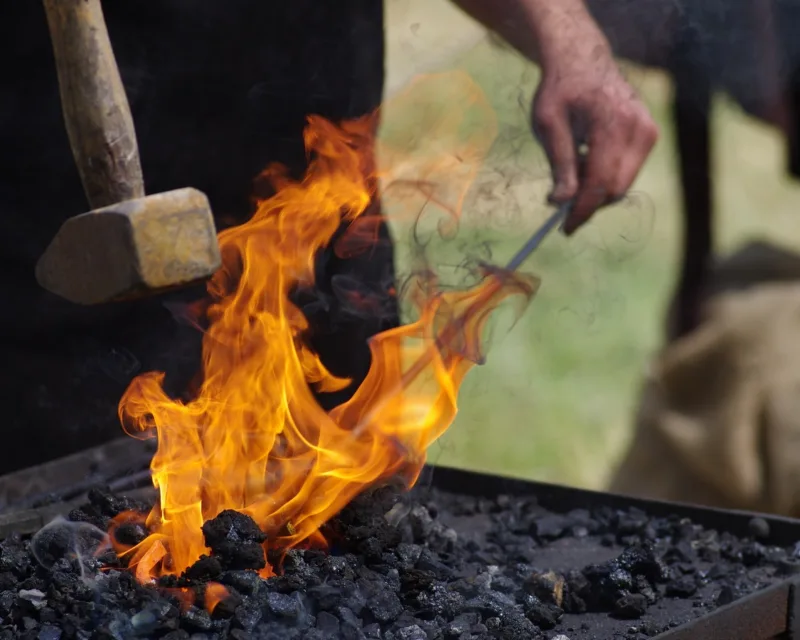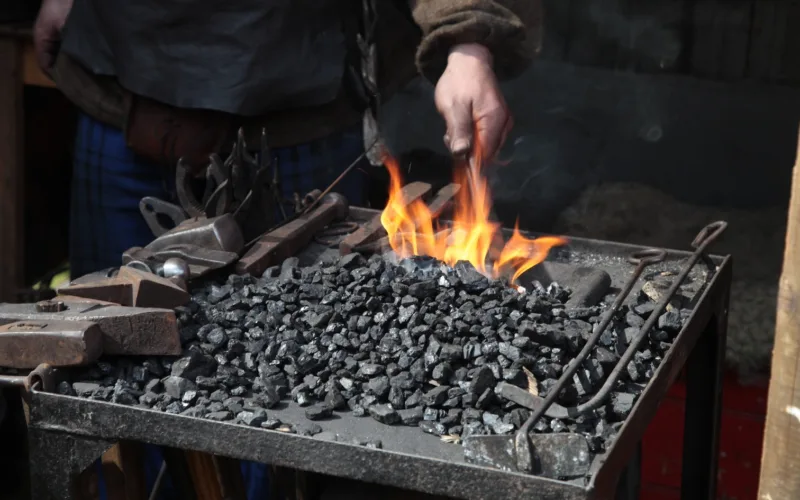Table of Contents Show
Introduction
A blacksmithing forge is at the heart of all metalworking projects. This type of hearth, used by blacksmiths, serves to heat and shape metals into usable objects and tools. The traditional design of a forge involves a basin with a heat source and an oxygen input, often through a pipe called the tuyere. As the oxygen enters, it brings the metals to a temperature where they can be easily worked and shaped.
For those who aspire to dabble in blacksmithing or take up the craft professionally, building your own forge can seem daunting. However, it’s entirely possible – and affordable – to construct your own using common materials.
This article will guide you through the process step-by-step. The DIY guide covers everything from understanding different types of forges to choosing the right one based on your needs and budget. It even includes detailed instructions on how to build a solid fuel forge from common materials.
Aspiring blacksmiths take note: your journey into the world of metalworking begins here!

Understanding Different Types of Blacksmithing Forges
1. Solid Fuel Forges (Coal Forge and Charcoal Forge)
A solid fuel forge is an old-school choice for many blacksmiths, and it’s easy to see why. These forges are built around the use of solid fuels such as coal or charcoal to generate heat. This traditional approach offers a tangible connection to the craft of blacksmithing, giving you an authentic hands-on experience.
Coal forges are particularly popular due to their high heat output. Coal burns hotter than wood or charcoal, making it perfect for heavy-duty blacksmithing projects. But there’s a caveat. Coal also produces more smoke and requires a well-designed chimney system for proper ventilation. Plus, sourcing good quality coal can sometimes be challenging.
On the other hand, charcoal forges are often preferred by beginners and hobbyists. Charcoal is easier to find and handle compared to coal. It’s less smoky, making it suitable for small indoor spaces or areas with limited ventilation. The downside? It doesn’t burn as hot as coal, so heating larger pieces of metal might take longer.
In terms of construction, a solid fuel forge is relatively straightforward to build. You need a fire pot to hold the fuel, an airflow system to feed oxygen into the fire (a tuyere), and a hearth pan to catch any falling embers or debris.
Pros and Cons of Solid Fuel Forges
Pros
- Cost-effective: Building a solid fuel forge can be inexpensive if you use common materials.
- Traditional feel: Using a coal or charcoal forge gives you a hands-on experience akin to traditional blacksmithing.
- Control over heat: With solid fuels, you have precise control over where and how intense the heat is in your fire.
Cons
- Fuel sourcing: Good quality coal can be hard to find.
- Smoke and soot: Coal forges can produce a lot of smoke and soot, requiring good ventilation.
- Fire management: Managing a solid fuel fire takes skill and practice.
Before we move on to the next type of forge, it’s worth noting that if you enjoy practical projects like this, you might also find these tools for building other DIY projects interesting.
2. Gas Forges (Propane-Fueled)
Gas forges are a popular choice among blacksmiths due to their efficiency and convenience. These forges, also known as propane-fueled forges, use propane as fuel. If you’re looking for a DIY project, building a gas forge at home is both feasible and exciting.
A gas forge uses propane or natural gas as fuel. This modern alternative offers convenience, cleanliness, and consistency.
Propane-fueled forges are especially popular among contemporary blacksmiths. They’re simple to operate – just turn on the gas and ignite. The flame is clean, reducing concerns about smoke or soot. Plus, the heat is consistent across the forge chamber, which can improve your workflow by allowing you to heat multiple pieces at once.
However, building a DIY propane forge requires a bit more technical know-how than a solid fuel forge. You’ll need to construct a safe and efficient gas delivery system, which can involve plumbing work and potentially welding.
Exploring Gas Forges
A gas forge uses propane or natural gas as its main fuel source. Inside the forge, the fuel combines with oxygen to create a flame that heats up your metalwork pieces. Here’s how it works:
- The fuel is ignited within an insulated chamber.
- The flame produced from this ignition generates heat.
- You use this heat to make your metalwork malleable.
Gas forges have a simple yet effective design, consisting of the following components:
- Metal body (usually cylindrical)
- Insulation lining the inside walls
- One or more burners supplying the fuel
- Openings at the ends for placing and removing workpieces
Building a Propane-Fueled Forge at Home
To build your own gas forge at home, gather these basic materials:
- Large metal can or old propane tank for the body
- Ceramic fiber blanket for insulation
- Propane torch as the heat source
- Propane regulator to control the flame intensity
Follow these steps during the construction process:
- Cut your chosen container to size.
- Line the interior of the container with a ceramic fiber blanket.
- Create holes at appropriate points: one for the burner and others at either end for placing and removing your workpiece.
Remember, working with gas appliances requires caution. Always check for leaks in your setup before igniting your forge.
Pros and Cons of Gas Forges
Before deciding on a gas forge, consider the following advantages and disadvantages:
Pros:
- Convenience: Gas forges are easy to light and maintain a constant temperature.
- Clean Burning: Propane burns cleanly, producing less smoke and fumes compared to coal or charcoal. This makes it suitable for indoor use as well.
- Controlled Environment: The enclosed structure of a gas forge allows for even heating of the metal.
Cons:
- Fuel Cost: Propane may be more expensive than coal or charcoal in the long run.
- Limited Space: Depending on your forge’s design, working with larger pieces can be challenging.
- Less Heat: While propane forges reach sufficient temperatures for most blacksmithing tasks, they usually don’t achieve the extreme heat levels of coal forges.
Choosing between a solid fuel forge (coal or charcoal forge) and a gas forge depends on various factors such as budget, available space, type of project, and personal preference. Assess your specific needs and circumstances before making a decision.
A gas forge provides a clean and controlled environment, making it ideal for detailed or intricate work. However, keep in mind the potential higher running cost compared to a solid fuel forge. Prioritize safety and efficiency while aligning your choice with your blacksmithing goals.
3. Induction Forges (Electric Induction Forges)
Lastly, we have the induction forge – a high-tech solution for blacksmith
If you’re interested in a more modern approach to blacksmithing, an electric induction forge might be just what you need. These forges, also known as induction forges, use advanced technology to heat metal quickly and precisely.
What is an Induction Forge?
Unlike traditional solid fuel or gas forges, an induction forge doesn’t rely on burning fuel to generate heat. Instead, it uses electrical currents to create heat through a process called electromagnetic induction. Here’s how it works:
- An induction coil is placed around the metal piece you want to heat.
- When electric current passes through the coil, it creates alternating magnetic fields.
- These magnetic fields induce an electric current within the metal, generating heat.
The result is a forge that can heat metal without any direct flame or fuel combustion.
Key Features of Electric Induction Forges
Induction forges are known for their specific qualities:
- Efficiency: These forges can heat metals quickly, often in less than a minute. The direct heating method minimizes energy loss.
- Precision: The heat is focused on the item inside the coil, allowing precise control over temperature and ensuring even heating.
- Safety: Without open flames or carbon monoxide production, induction forges are much safer to use than traditional forges.
- Cleanliness: They operate without producing smoke or soot, making them environmentally friendly and providing clean working conditions.
Pros and Cons of Electric Induction Forges
Like any tool, induction forges have their advantages and disadvantages.
Advantages:
- Speed: An induction forge can quickly reach high temperatures, reducing waiting time.
- Control: Precise temperature control allows for more consistency in your work.
- Safety: The lack of open flames reduces fire risks significantly.
- Clean operation: No smoke means cleaner air in your workspace.
Limitations:
- Cost: Induction forges can be quite expensive compared to DIY solid fuel or gas forges. The high upfront cost is often a barrier for hobbyists.
- Power requirements: These forges require a significant amount of electrical power to operate, which can increase your energy bills.
- Size restrictions: The size of the workpiece is limited by the size of the induction coil.
Building Your Own Induction Forge
While building an induction forge at home can be challenging due to its complex design and high-power requirements, it’s not impossible. Here are some things to consider if you’re thinking about building your own forge:
- There are numerous online guides and resources available that provide instructions on how to build an induction heater.
- Working with high-voltage electricity requires a thorough understanding of electrical safety protocols, so make sure you educate yourself before starting.
- The components you’ll need for a DIY induction forge include an induction heating module, power supply, cooling system, and a coil that’s sized appropriately for your intended workpieces.
- Safety should always be a top priority when constructing or operating any type of forge. Make sure to use proper safety equipment such as electrical gloves and eye protection.
Induction forges combine traditional blacksmithing techniques with modern technology. While they may not be the most beginner-friendly option due to their cost and complexity, they offer significant benefits in terms of speed, precision, and safety. By understanding how these forges work, you can make an informed decision about whether they’re the right choice for your blacksmithing goals.
Choosing the Right Type of Forge for Your Needs
Selecting the appropriate forge type for your metalworking activities involves a series of considerations. Here, we’ll delve into these factors to guide you in choosing the perfect DIY forge.
Budget
The first aspect to consider is your budget. Here’s how different forge types compare in terms of cost:
- Solid fuel forges (coal and charcoal): generally more affordable, especially if you source materials locally.
- Gas forges (propane-fueled): higher initial costs but offer better efficiency.
- Induction forges: can be pricey due to their advanced technology.
Project Requirements
Different projects call for different heating capabilities. Consider the type of metal you’ll be working with:
- If your metalworking projects involve steel or iron, a solid fuel or gas forge might be ideal as they can reach high enough temperatures.
- However, if you’re working with softer metals like copper and bronze, an induction forge could suffice.
Skill Level
Your blacksmithing experience can also influence your choice. Here’s a suggestion based on skill level:
- Beginner: start with a simple charcoal or coal forge. This allows hands-on learning of heat control.
- Intermediate/Advanced: consider upgrading to a gas or induction forge as you gain mastery over temperature regulation.
Space and Ventilation
Lastly, consider your workspace’s size and ventilation. Here’s how different forge types fare in this aspect:
- Solid fuel forges: often produce more smoke and require good airflow, making them more suited for outdoor spaces.
- Gas and induction forges: cleaner and can operate indoors with proper precautions.
These factors should guide you towards choosing the most suitable type of blacksmithing forge for your needs.
Step-by-Step Guide: Building a Solid Fuel Forge from Common Materials
1. Gathering the Necessary Materials and Tools
Before you start building your solid fuel forge, make sure you have all the materials and tools you need. This will help save time and make the process smoother. Here’s what you’ll need:
Materials:
- Steel container – This will be the base of your forge. You can use things like an old barbecue grill, brake drum, or even a large stainless steel soup can.
- Steel pipe – This will be used as the tuyere, which is the pipe that delivers air to your fire. A pipe with a diameter of 1 1/2″ to 2″ is ideal.
- Fire bricks – These are used to line the inside of your forge and help retain heat.
- Charcoal or coal – Choose one as your fuel source based on what’s available to you and your personal preference.
Optional Material:
Plaster of Paris and sand mixture – This is an affordable option for making a homemade refractory coating. It can help protect the steel container from high temperatures.
Tools:
Welder – You’ll need this to create strong joints when assembling your forge.
Angle grinder with cutting disc – This tool will come in handy for cutting steel to the desired size.
Drill with metal drilling bits – Use this to make holes in the steel container for the tuyere.
Remember, safety should always come first when working on any project. Make sure to wear the appropriate safety gear, such as safety glasses and fire-resistant gloves. Also, work in a well-ventilated area to avoid breathing in any harmful fumes.
The exact list of materials and tools may vary depending on what you have access to and the specific design you’re following. The goal is to create a forge that works for you, so feel free to make adjustments as needed!
Now that you have everything you need, let’s move on to the next step: constructing the hearth pan, which is an important part of any forge.
2. Building the Hearth Pan
Embarking on your DIY solid fuel forge project requires a step-by-step approach. One of the most critical stages is constructing the hearth pan, which serves as the base for your forge.
Materials Needed:
- Angle iron
- Steel tubing
You can find these materials at hardware stores or metal suppliers since they are popular choices due to their durability and ability to withstand high temperatures.
Why a Sturdy Hearth Pan Matters
Ensuring you build a robust and sturdy hearth pan is paramount for the overall stability of your forge.
Step-by-Step Guide:
- Start by measuring out the desired dimensions of your hearth pan based on your project’s needs. As a suggestion, a size of approximately 24 by 30 inches should be adequate for most beginner projects.
- Cut four pieces of angle iron to match these dimensions. Make sure to keep your measurements accurate; any discrepancies can lead to unstable joints.
- Arrange these pieces into a rectangle, with each end meeting at a right angle. This forms the frame of your hearth pan.
- Using your welder, fuse each joint together. To achieve sturdy joints, hold the welder at a 45-degree angle to the joint and move in small circular motions until you’ve created a molten pool that fuses the two pieces together.
- Once all four corners are welded, let the frame cool down before proceeding.
- Cut out a piece of steel tubing that matches the size of your frame. This will serve as the floor of your hearth pan.
- Weld this steel tubing onto the bottom of your angle iron frame.
Remember that working with hot metals carries risks, so maintaining safety measures throughout this process is crucial. Always use protective gear including safety glasses and fire-resistant gloves when handling hot materials or operating machinery like welders.
This step-by-step guide should help you construct a reliable hearth pan for your forge. Using readily available materials and tools, you’re well on your way to creating a functional coal or charcoal forge.
3. Constructing the Tuyere and Chimney System
As you continue with your DIY solid fuel forge project, it’s time to construct the tuyere and chimney system. These components are integral for controlling airflow and maintaining high temperatures within your forge.
What is a Tuyere and Why is it Important?
The tuyere is a pipe or conduit through which air is forced into the fire. It plays a crucial role in managing airflow, allowing you to control the heat level in the forge. The design of this part holds high importance since improper airflow can cause insufficient heat or even extinguish the fire.
Steps to Build a Tuyere:
To construct a simple tuyere, you will need:
- 1-inch diameter steel pipe (approximately 12 inches long)
- A standard air gate valve
- An air source (a shop-vac or hairdryer will suffice for beginners)
Here’s how you can build it:
- Connect one end of the steel pipe to your chosen air source.
- Insert the other end into your hearth pan so that it sits just above the bottom. This ensures maximum exposure to your solid fuel source.
- To control the flow of air, install an air gate valve on the pipe close to the air source.
Understanding the Chimney Mechanism and its Purpose:
Next up is building an effective chimney mechanism. Its purpose is to guide smoke and hot gases safely away from your work area, making proper ventilation design a necessity for safe operation.
Steps to Build a Chimney Mechanism:
Building a chimney requires:
- Metal sheets or ducting
- High-temperature resistant paint
Here’s how you can build it:
- Bend the metal sheets or ducting into a cylindrical shape with an opening wide enough to cover your hearth pan.
- Attach this cylinder vertically above your hearth pan using brackets or supports, ensuring it’s sturdy and secure.
- Apply high-temperature-resistant paint on all external surfaces for added durability.
For those who prefer traditional methods, incorporating a bellows for manual air supply is an option. Constructing one from scratch can be complicated, but several affordable, ready-made options are available in the market. The bellows can be attached to the tuyere system, replacing your electric air source.
Forge building materials and tools used throughout this process should be handled with care, underlining the importance of safety equipment such as fire-resistant gloves and safety glasses. With these steps, you have successfully constructed a functional tuyere and chimney system for your blacksmith forge.
4. Applying Insulating Refractory Coating
Building a DIY solid fuel forge entails more than constructing the physical structure; it’s essential to consider heat efficiency and safety. One method to achieve this is by applying an insulating refractory coating, which enhances heat retention within the forge. This not only ensures you achieve the desired temperatures for metalworking but also minimizes heat escape, keeping surrounding surfaces cooler and safer.
Why Use an Insulating Refractory Coating?
An insulating refractory coating helps improve heat efficiency in your forge by:
- Retaining Heat: The coating acts as a barrier, preventing heat from escaping quickly and maintaining higher temperatures inside the forge.
- Protecting Surfaces: By reducing heat transfer, it keeps the outer surface of the forge cooler, minimizing the risk of accidental burns or damage to surrounding objects.
Using Plaster of Paris as a Homemade Refractory Coating
Plaster of Paris, a common and readily available material, can serve as an effective homemade refractory coating. Here is a simple method to apply Plaster of Paris to your forge:
Materials Needed:
- Plaster of Paris
- Sand
- Water
- Mixing container
- Paintbrush or trowel
Procedure:
- Prepare the Mixture: In your mixing container, combine equal parts of Plaster of Paris and sand. Add in water gradually, stirring until the mixture achieves a thick, paint-like consistency.
- Apply the Coating: Use your paintbrush or trowel to apply the mixture onto the interior surfaces of your forge, ensuring all areas are evenly covered. Aim for a layer thickness between 1/2 inch to 1 inch.
- Let it Dry: Allow the coating to dry completely before proceeding with any further steps. This might take several hours or even overnight depending on environmental conditions.
Remember that safety should be paramount throughout this process. Make sure you’re wearing appropriate safety equipment, including gloves and protective eyewear while handling these materials.
Once your refractory coating has dried completely, you’re ready for the next step in building your own forge from common materials. The subsequent section will guide you through setting up your chosen fuel source and ignition system for your DIY solid fuel forge.
5. Setting Up the Fuel Source and Ignition System
When you’re ready to bring your DIY solid fuel forge to life, selecting the appropriate fuel source and ignition system is essential. Both charcoal and coal are widely used in blacksmithing for their heat-producing capabilities, and each comes with specific handling and ignition characteristics.
Fuel Options:
Charcoal:
- Lightweight and easy to ignite.
- Burns cleaner with less smoke compared to coal.
- Requires more frequent refueling due to faster burnout.
Coal:
- Provides a longer-lasting burn than charcoal.
- Generates more heat, ideal for forging larger pieces.
- Produces clinker, which requires periodic cleaning from the forge.
Ignition Methods:
1. For Charcoal:
- Begin by filling the forge’s hearth pan with a modest amount of charcoal.
- Use a match or lighter to ignite a firestarter, such as paper or kindling, placed underneath or within the charcoal pile.
- Once the initial pieces catch fire, gently blow or use a hand-cranked blower to intensify the heat until the charcoal is lit.
2. For Coal:
- Start with a layer of charcoal as a base to aid in the ignition of coal.
- Place coal around the burning charcoal, not directly over it, allowing it to gradually heat up.
- Apply air flow strategically; too much can scatter unlit coal while too little may extinguish your flames.
Remember that managing airflow is crucial for both types of solid fuel forges. An electric blower or hand-cranked bellows will supply the oxygen necessary for maintaining high temperatures. Adjust airflow accordingly to control the intensity of your fire.
Safety Precautions:
- Wear safety glasses and fire-resistant gloves when working with fuel sources and ignition systems.
- Ensure your workspace is well-ventilated to prevent buildup of harmful gases like carbon monoxide.
By adhering strictly to safety practices and understanding the nuances between charcoal and coal usage, you can set up an efficient fuel source for your solid fuel forge. With your fuels prepared and ignition techniques honed, you’ll be equipped to proceed with confidence into the rewarding world of blacksmithing.
Operating Safely and Maintaining Your Homemade Forge
Operating your forge safely should be your top priority. While blacksmithing is an enjoyable craft, it also involves handling high temperatures and potentially hazardous materials. Here are some core guidelines to follow:
Wear Protective Gear
Always wear safety glasses, fire-resistant gloves, a sturdy apron, and closed-toe shoes. This gear will protect you from sparks, hot metal shavings, and direct heat.
Work in a Ventilated Space
Ensure that your working area is well-ventilated to prevent the build-up of harmful gases.
Fire Precautions
Keep a fire extinguisher nearby when operating the forge. Avoid any flammable materials in the immediate vicinity.
Regular maintenance of your forge ensures its longevity and optimal performance.
Routine Inspection
Regularly check for signs of wear or damage on your forge. This includes cracks in the refractory coating, blockages in the tuyere, or any loose parts.
Cleaning After Use
Remove ash and leftover fuel after each use. This prevents buildup which could affect the forge’s performance.
Refractory Coating Care
If you notice any cracks or chips in the refractory coating, repair them with additional Plaster of Paris. Regular maintenance ensures the coating is effective at insulating the forge and retaining heat.
Remember, a well-maintained and safely operated forge not only makes blacksmithing more enjoyable but also extends the life of your homemade equipment.
Conclusion
Building your own blacksmithing forge from common materials is not just an accomplishment; it’s the beginning of a journey. Crafting tools, shaping metal, and bringing your creative visions to life all become possible when you have a forge at your disposal. The satisfaction derived from constructing a forge with your own hands is unmatched and creates a deeper connection with your metalworking projects.
The beauty of this process lies in its simplicity and accessibility. You don’t need to invest in expensive equipment or possess advanced technical skills. With this comprehensive guide, you have all the necessary information right at your fingertips.
Remember:
- Safety is paramount when operating a blacksmithing forge.
- Regular maintenance will ensure the longevity and performance of your home-built forge.
- Different types of forges suit different needs – choose wisely based on budget, project requirements, and skill level.
Don’t wait for tomorrow. Start gathering materials, plan out your design, and begin crafting something unique. Remember that each step is a learning experience and part of the overall journey. It’s time to embrace the spirit of craftsmanship, ignite that spark of creativity within you, and create something truly extraordinary.
The world of blacksmithing awaits!
Blacksmithing – Building a simple DIY forge | Youtube Video
FAQs (Frequently Asked Questions)
[saswp_tiny_multiple_faq headline-0=”h3″ question-0=”What are the different types of blacksmithing forges?” answer-0=”There are three main types of blacksmithing forges: solid fuel forges (such as coal and charcoal forges), gas forges (propane-fueled), and electric induction forges.” image-0=”” headline-1=”h3″ question-1=”What are the pros and cons of solid fuel forges?” answer-1=”Pros of solid fuel forges include cost-effectiveness and the ability to use common materials. Cons may include more maintenance and cleanup compared to other forge types.” image-1=”” headline-2=”h3″ question-2=”What are the key features of electric induction forges?” answer-2=”Electric induction forges are known for their efficiency, precise heating capabilities, and minimal environmental impact due to their clean operation.” image-2=”” headline-3=”h3″ question-3=”What materials and tools are needed to build a solid fuel forge?” answer-3=”To build a solid fuel forge, you will need angle iron, steel tubing, and other common materials that can be found at hardware stores.” image-3=”” headline-4=”h3″ question-4=”How can I ensure safety when operating a homemade forge?” answer-4=”To ensure safety when operating a homemade forge, it is important to wear protective gear such as safety glasses and fire-resistant gloves, work in a well-ventilated space, take fire precautions, and perform routine inspections and cleaning after use.” image-4=”” headline-5=”h3″ question-5=”Why use an insulating refractory coating when building a DIY solid fuel forge?” answer-5=”Using an insulating refractory coating helps improve heat efficiency and provides insulation to the forge, ultimately enhancing its performance.” image-5=”” count=”6″ html=”true”]Citation
- Marks, Terran. 2015. The DIY Blacksmithing Book. Createspace Independent Publishing Platform.
- Steel, Les. 2020. Blacksmithing Ultimate Blacksmithing Beginners Guide. Chronos Publishing LLC.
- Jackson, Adam, and Ervin Hartmann. 2017. Woodworking and Blacksmithing. Createspace Independent Publishing Platform.
- Abu-Izmero, Hassan. 2016. ‘DIY | Building a forge.’ Video, 12:37. https://www.youtube.com/watch?v=2ImNzlOXAUQ. Accessed January 8, 2024.
- Åhman, Torbjörn. 2018. ‘Blacksmithing – Building a simple DIY forge.’ YouTube video, 14:49. https://www.youtube.com/watch?v=m-R6iY-mY-Y. Accessed January 8, 2024.
- Black Beard Projects. 2016. ‘DIY Blacksmithing Forge.’ YouTube video, 18:05. https://www.youtube.com/watch?v=d2dEaZnzEvU. Accessed January 8, 2024.
- Essential Craftsman. 2019. ‘Forge Build: No Welding Required.’ YouTube video, 1:04:23. https://www.youtube.com/watch?v=TS7wumQt0s8. Accessed January 8, 2024.











